Comptroller Kevin Lembo Archive > News
COMPTROLLER LEMBO PROJECTS $70.9-MILLION DEFICIT FOR FISCAL YEAR 2015A final deficit for FY 2015 will be determined later this year after the state's financial books are audited and closed. Any remaining General Fund deficit for FY 15 will be eliminated through a transfer from the Budget Reserve Fund at the end of this calendar year.
In a letter to Gov. Dannel P. Malloy, Lembo said he is in general agreement with the Office of Policy and Management's (OPM) latest deficit estimate, which decreased by $44.8 million from last month's projection.
"The slow growth in General Fund revenue during the 2015 fiscal year produced significant budget challenges in order to mitigate a sizeable deficit," Lembo said. "Active budget management held spending growth to under 3 percent in Fiscal-Year 2015 compared to last fiscal year.
"While the administration's efforts to manage spending helped significantly to reduce the deficit, there is a great need to evaluate and address persistently slow wage growth. Despite significant job growth during FY 2015, the payroll-driven withholding portion of the income tax has failed to generate the anticipated gains."
Lembo pointed to a recent study by the Federal Reserve Bank of Cleveland that found a significant correlation between wage growth and two economic variables: productivity increases and labor's share of income.
"The study is saying that a declining trend in the hourly output of workers, along with businesses opting to invest more heavily in capital equipment and other non-payroll spending has depressed wage growth," Lembo said. "If businesses can effectively substitute equipment, technology or outsourcing for local workers, then there is no need to increase wages to attract or retain skilled labor.
"There are many theories about the decline in worker productivity - including receding business investment in education or training for workers, and less investment in technologies used by workers to be productive. This is consistent with a business model that has shifted to investing in non-payroll alternatives to production such as increased use of advanced machinery and other technologies, and utilizing lower-cost global outsourcing.
"The state must seriously consider and explore the many possible policy remedies - because, while jobs continue to grow, so must wages."
General Fund revenue for FY 15 is expected to fall $144.5 million below initial budget expectations. The largest single downward revision is in the income tax, which is projected to close the fiscal year $110.5 million short of budget expectations, Lembo said.
The most significant revenue increase is in the corporation tax, which is expected to exceed the initial budget amount by $107.7 million. Expanded tax credits were projected to reduce corporate payments during the fiscal year; however, the corporation tax is now estimated to grown 3.8 percent over last fiscal year. Lembo said the growth is, in part, attributable to the Department of Revenue Services' initiative to settle outstanding corporation tax issues, which resulted in a gain of $31.6 million in this area.
Total General Fund revenue growth for FY 15 is expected to be approximately 1.8 percent above last fiscal year.
General Fund spending for FY 15 is projected to fall more than $70 million below the initial budget plan.
"As I have been reporting, the state's overall economic climate has been gradually improving," Lembo said. He pointed to the latest economic indicators from federal and state Departments of Labor and other sources that show:

• Through June of Fiscal Year 2015, the year-to-date withholding portion of
the income tax was running 2.5 percent above the same period last year. This
analysis does not include comparative tax accrual data between fiscal years
because accrual activity is posted through the first week of August. For most of
Fiscal Year 2015, withholding receipts have been running slightly below the
levels experienced in the prior fiscal year.
• Withholding receipts are the largest single source of state tax revenue,
accounting for 62 percent of the total income tax receipts in Fiscal Year 2014
and almost 40 percent of total tax receipts in that year. As can be seen from
the graph below, with the exception of the increases experienced in Fiscal Years
2011 and 2012 that resulted from tax increases, withholding growth has been well
below normal post-recession levels.
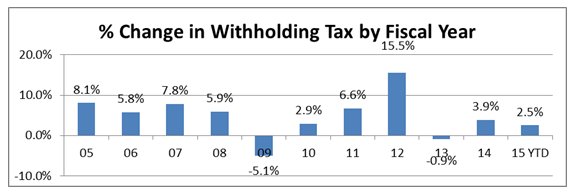
• According to the Department of Labor, preliminary figures show that Connecticut gained 600 payroll positions in June. This follows the addition of 5,900 jobs in May (revised down from a preliminary figure of 6,400 jobs). Connecticut has gained 27,000 jobs over the past 12-month period, which brings total payroll employment in the state to 1,691,900. Over the entire 2014 calendar year, the state added 25,100 payroll positions.

• Connecticut has now recovered 97,900 positions, or 82.3 percent of the 119,000
seasonally adjusted total nonfarm jobs that were lost in the state during the
March 2008 - February 2010 employment recession. The state's jobs recovery is
now more than five years old and is averaging about 1,530 jobs per month since
February 2010.
• The state needs to reach the 1,713,000 job level to enter a nonfarm employment
expansionary phase. This will require an additional 21,100 nonfarm jobs. A total
of just 6,400 more private-sector positions are needed to have a fully recovered
private sector.
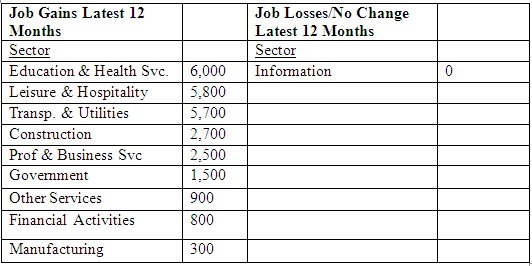
• U.S. employment has been advancing at a rate of 2.1 percent over the
12-month period ending in June; Connecticut's employment growth was 1.6 percent
for the same period.
• Connecticut's unemployment rate was 5.7 percent in June; the national
unemployment rate was 5.3 percent. Connecticut's unemployment rate has continued
to decline from a high of 9.5 percent in October 2010. Currently, unemployment
ranges from a low of 2.6 percent in Nebraska to a high of 7.4 percent in West
Virginia.
• There are 109,000 unemployed job seekers in Connecticut. A low of 36,500
unemployed workers was recorded in October of 2000. The number of unemployed
state workers hit a recessionary high of 177,200 in December of 2010.
![]()
• The Department of Labor reports that average hourly earnings at $28.64, not
seasonally adjusted, were up 51 cents, or 1.8 percent, from the June 2014
average. The resultant average private-sector weekly pay was calculated at
$953.71, up just $2.92, or 0.3 percent higher than a year ago.
• The graph below shows the year-over-year percent change in hourly
private-sector wages in Connecticut. Wage growth was exceeding 6 percent as the
state entered the recession and has exhibited an erratic pattern in the
post-recession period. This trend has contributed to the slow growth in state
withholding tax receipts discussed above and has resulted in significant budget
challenges in each year of the recovery.

• The abnormally slow rate of growth in wages has also been experienced at
the national level and has been at the center of national and state debates on
appropriate wage rates.
• The Cleveland Federal Reserve Bank published a study in April that found a
significant correlation between wage growth and two economic variables 1)
productivity increases and, 2) labor's share of income. Both have been in
decline since the recession.
• The graph below shows US productivity changes since 1947. Productivity is a
measure of worker output per hour. More recent productivity results have been
even more disappointing than the graphic. From the first quarter of 2014 to the
first quarter of 2015, productivity increased just 0.3 percent.
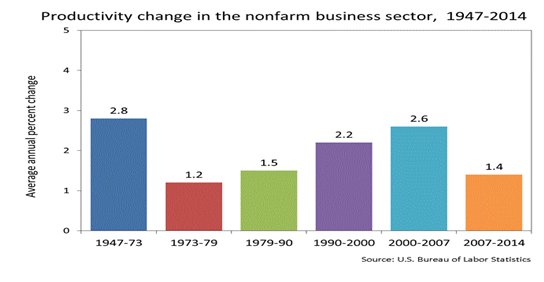
• Between 1980 and 2014 labor income as a share of GDP has declined from 58.4 percent to 52.2 percent. This decline has also ocurred in labor's share of corporate income.
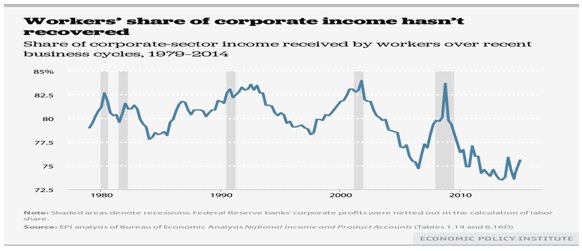
• The Federal Reserve Report found no economic forces that were positioned to
reverse the slow wage growth in the short term.
• Based on data released by the Bureau of Economic Analysis on June 22 for the
first quarter of 2015, personal income in Connecticut grew at a rate of 3.5
percent from the same quarter last year. This compares to a national growth rate
of 4.4 percent. Connecticut was ranked 24th nationally in quarterly growth based
on first-quarter data. Results for the second quarter will be released on Sept.
30.
• The chart below shows the annual trend in Connecticut personal income over
time, which is well off the pace set during the last post-recessionary period.
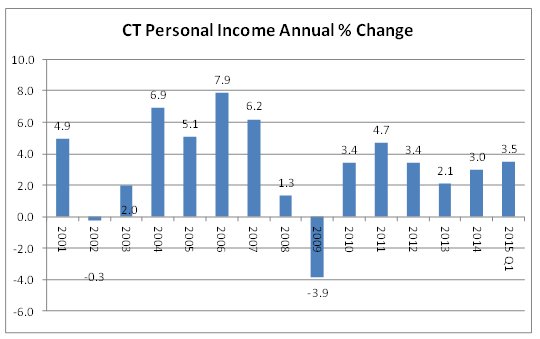
•

- According to a report from the Connecticut Realtors Association released on July 9, Connecticut single-family home sales rose 13.9 percent in June from the same month last year. The median home price fell over that period from $276,950 to $275,000. The sale of townhouses and condominium in the state rose by 1.1 percent from June of last year. The median price of those units decreased to $169,000 from $174,500.
- The National Association of Realtors reported that June existing home sales in the U.S. were up 9.6 percent in June from a year ago. Median home prices rose 6.5 percent from June of last year to $236,400. The percent share of first-time buyers fell to 30 percent in June from 32 percent in May, but remained at or above 30 percent for the fourth consecutive month. A year ago, first-time buyers represented 28 percent of all buyers. Historically, first-time buyers have been at just over 40 percent of the market and peaked at over 50 percent between 2009 and 2010.
- According to Freddie Mac, the average commitment rate for a 30-year, conventional, fixed-rate mortgage rose in June to 3.98 percent from 3.84 percent in May, but remained just below 4 percent for the seventh straight month.
Consumers
• Sales tax receipts through June of Fiscal Year 2015 were up 3.5 percent
over last year. The sales tax is on track to complete the year at least $43.8
million above the original budget estimate. Tax accruals in this category are
still being processed. Sales tax growth is at a relatively normal post-recession
level.
• June advance retail sales were up 1.4 percent from one year ago. Food services
and drinking places had the strongest gain at 7.7 percent followed by auto sales
at 7.1 percent and sporting goods, hobby, book and music stores up 6.6 percent.
Gasoline stations continued to post double-digit declines due to the low price
of gasoline as compared to June of last year.
• The Federal Reserve reported that consumer borrowing eased in May growing at a
seasonally adjusted annual rate of 5.7 percent. In the two prior months,
consumer credit had expanded at a rate of just over 7.5 percent. Revolving
credit, primarily credit cards, increased at an annual rate of 2.1 percent,
while non-revolving credit, which includes auto loans and student loans,
increased at an annual rate of 7 percent.
• Consumer confidence declined in July on concerns global risks will dim
prospects for the U.S. economy. The Greek financial crisis and a slowdown in
China were mentioned by respondents in the survey and help explain why Americans
were less upbeat about the domestic economy. Even with the decline in sentiment,
July marks the eighth straight month the Michigan gauge has been above 90, the
longest stretch since a 17-month period ended in early 2005.
Business and Economic Growth
• On July 30, the Bureau of Economic Analysis reported that advance estimates
showed second-quarter real GDP growth of 2.3 percent. Growth in the first
quarter of 2015 was revised to growth of 0.6 percent.
• Corporate profits were down 5.8 percent in the first quarter of 2015 after
rising 1.7 percent in 2014. Profits before taxes were up 1.8 percent in the
first quarter.
• The Department of Labor's General Drift Indicators are composite measures of
the four-quarter change in three coincident (Connecticut Manufacturing
Production Index, nonfarm employment, and real personal income) and four leading
(housing permits, manufacturing average weekly hours, Hartford help-wanted
advertising, and initial unemployment claims) economic variables, and are
indexed so 1986 = 100. The index has been showing a general upward trend,
although it remains well below pre-recession levels.
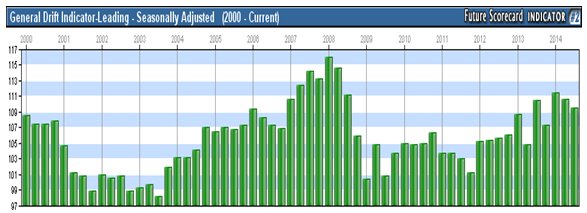
Stock Market
• Estimated income tax payments, which are influenced by capital gains
receipts, were trending 5.3 percent higher on a year-to-date basis thru June.
• The final payment portion of the income tax was growing at a year-to-date rate
of 12.8 percent through June as compared to the same period last year. This was
under budget expectations and resulted in a downward adjustment in the income
tax estimate of $65.5 million in April from the initial budget projection.
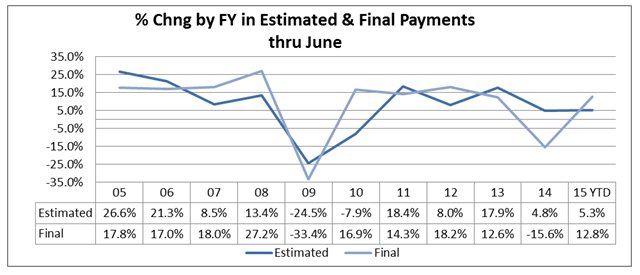
• Over the past 12 months, the Dow has posted a gain of 4.8-percent with significant monthly swings.

• As a result of the monthly volatility, the Dow has shown little movement on
a year-to-date basis.
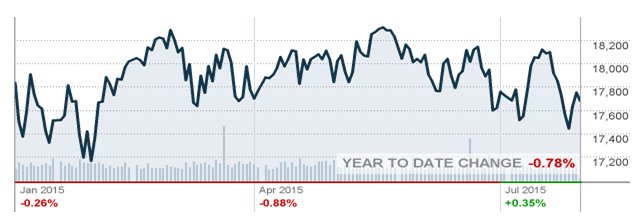
***END***
